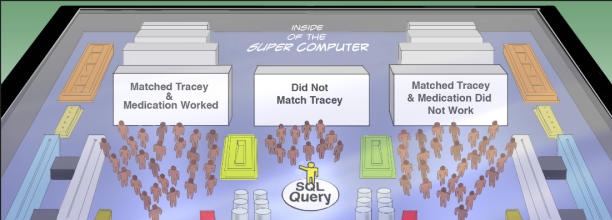

Description
This course introduces students to design and use of health and medical
databases. It provides hands-on experience with use of Microsoft Access
and MySQL databases. It explores use of electronic medical records and
examines the application of information systems to clinical and managerial
transactions. Students learn to create, maintain and analyze healthcare
databases. Applications to analysis of data in electronic health records
to clinical decision aids are discussed.
Overview Video►
Course Objectives
At the conclusion of the
course participants should be able to:
- Effectively manage healthcare information using MS Access database tool.
- Design healthcare databases.
- Structure queries and reports to describe complex relationships between
fields in healthcare databases.
- Optimize data structures and tables that eliminate duplication,
unnecessary data entry, and confusion.
- Import, export, and link data tables across platforms.
- Merge, analyze, and query healthcare databases to produce new
information.
Program Competencies Addressed
For an overview of competencies needed for management of health information systems, see some of these resources:
Slides►
Listen►
MP4►
You Tube►
Read►
- Q4. Analyze the purpose, benefits, applications, and evaluation of clinical information systems
- Q5. Analyze the purpose, benefits, applications, and evaluation of management information systems
- Q.6 Use information systems to plan improvements in the quality and safety of patient care
- A.4 Apply quantitative methods and evidence from research studies to assist in making management decisions and assessing the quality of patient care
Required Textbooks
- None. All required reading is posted to the web. Use the
instructor's last name to gain access to password protected items.
- Hernandez MJ. Database design for mere mortals, a hands-on guide to relational database design
More►
- Taylor AG.
SQL for dummies: A reference for the
rest of us.
More►
A bachelor
or higher degree from an accredited University. The course is limited to
graduate students.
Familiarity with the US health care system. All examples are from the US
health care system.
Computer,
modem, microphone, speaker, phone line and Internet connection. A fast
computer and modem will save you considerable time in this course.
Daily use
of email, including ability to attach files to emails.
Microsoft
Power Point is needed for viewing some portions of reading and reporting on
projects.
-
A microphone is need
to narrate Power Point slides
-
Both
clinicians and managers are encouraged to enroll.
Teaching Methods/Strategies
This course is organized on the principles of "Learn one, Do one, Teach one."
Students learn by listening to recorded lectures or interacting with the face to
face or online instructors. The learning is reinforced by asking students
to teach within a topic. More►
Participation is key to making the
experience of everyone a pleasant one. Participation means that you need to review all course
sections and complete all exercises provided on a timely basis (maximum of one
week after lecture date), ask questions about the topic and evaluate the topic
presentations. Weekly assignments are graded as pass/fail.
| Assignment |
Percent
of Grade |
| Individual assignments |
25% |
| Team assignments |
35% |
| Teach one assignment |
15% |
| Final project |
25% |
Here is how the letter grades will be assigned:
| Score |
Letter Grade
|
|
93+ |
A
|
|
90-92 |
A
-
|
|
87-89 |
B
+
|
|
83-86 |
B
|
|
80-82 |
B -
|
|
70-79 |
C
|
|
70 - |
F
|
Topical Outline
- Introduction and Software Download
More►
- Basic SQL and Data Cleaning More►
- SQL for Predictive Models More►
- Accuracy of Predictions
More►
- Procedures and Nested Queries More►
- Repeated SQL and Query Optimization More►
- Normalization and Entity Relationship Diagrams More►
- Review and Reporting of Data More►
Are You Receiving Our Emails?
If you have enrolled in this course, you would receive weekly or more frequent communications
from the course faculty. If you are not receiving these emails, then we
must have a wrong email for you. Please contact your instructor
Email►
This page is part of the course on Clinical databases. It was first created in 1996. It was last edited on
08/28/2018 by Farrokh Alemi, Ph.D. © Copyright protected.
|

